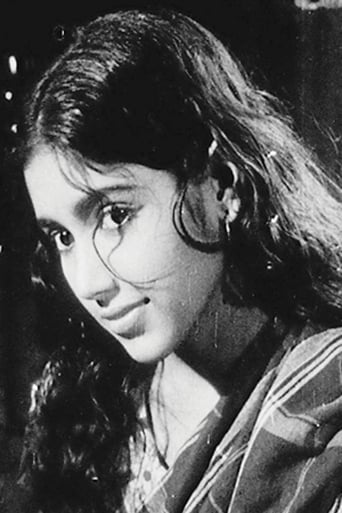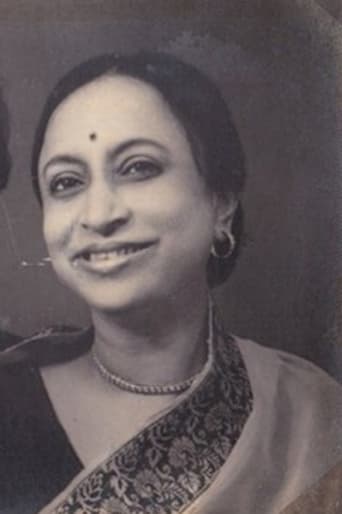Perry Kate
Very very predictable, including the post credit scene !!!
AshUnow
This is a small, humorous movie in some ways, but it has a huge heart. What a nice experience.
Nayan Gough
A great movie, one of the best of this year. There was a bit of confusion at one point in the plot, but nothing serious.
Nicole
I enjoyed watching this film and would recommend other to give it a try , (as I am) but this movie, although enjoyable to watch due to the better than average acting fails to add anything new to its storyline that is all too familiar to these types of movies.
Hans Grob
Again an uneatable work by Ghatak.At least for the Westerner, who does not have much of a clue about Hindouistic mythology and the life style of the Bengali people. Confusing. Contains scenes where someone tells short stories. Deterrent for good film making. Hitchcock would have not liked. I tried to remember pieces of seeming senseless conversation parts. I could for one: "I knew a man who could recite the whole Mahabharata ..." Would you embrace and be impressed by a Western film wherein you hear someone stating: "I know a man who knows the whole Bible by heart"? These may be cultural relativity. But filmmaking should not be dependent so much on it, especially its technical aspects. I have hardly ever seen a worse photography, a worse soundtrack. When the scenery consists of a talking group of people, we see them occupying the lower third of the frame, the lower limb cut off. About half of the frame is filled by the sky! No sort of surrealism or experimentation or exxageration.The sound in the mostly open air, natural village background sounds shouting like if recorded in a narrow hall.
asifami
1. River and River and life related to that clearly depicted in the film Titas( Name of a river and peoples around it ) Ekti Nodir Naam ( Name ). 2. Clearly depicts how peoples of different religion lives side by side without effecting their livelihood. and still role is being played by the peoples who are rich and who are poor . In the name of religion , they created sect , actually which represents the privileged peoples and peoples who lives on fishing, farming and united . But some how money divides them actually rich uses it as a tool to destroy the unity and peace of a community.3. River scenes, Boats and Rain greatly depicted in the film, excellent cinematography
lchadbou-326-26592
A River Called Titas (also known as Time And The River) is a somewhat more sprawling later melodrama of Bengal poverty, compared to director Ritwik Ghatak's more famous earlier The Cloud-Capped Star, but just as interesting. The stories it weaves together are set in the Malo fishing community of East Bengal, now Bangladesh, the area where the director grew up. Kishore, a young fisherman who we saw as a boy in the opening, is hastily married to a young woman from a neighborhood he is visiting, so the two communities can seal a friendship. He hardly comes to know his new bride or get a good look at her when, in a scene reminiscent of the melodramatic character separations in Mizoguchi, bandits capture her at night while they are still on the water, and sleeping apart.When she gets away and floats to shore this kidnapped girl, who never even knew her husband's name, gives birth to a son, Ananta, and goes to work in the home of a more well off woman, where they process hemp to be used by the fishermen.That lady is Mungli, one of the two little girls we had seen with the young Kishore in the beginning. Ironically Kishore is in the same village but has gone crazy and keeps to himself. The wife feels a strange bond with this man, as she is somewhat estranged from the community herself. She offers to bathe him in the river. Basanti, the other girl who had befriended the wife and had lost her own husband in a fishing accident, takes care of the boy after the parents, briefly reunited, are set upon by ruffians and killed (another scene reminiscent of Mizoguchi)The boy imagines he sees his mother, brilliantly attired in the forest, as the goddess of motherhood. The son is then thrown out of Basanti's home and goes to live with others. The film climaxes with the struggle between rich creditors and the fishermen who owe them money. At one point in an inspiring Marxist moment two women hurl one of the creditors into the water. Another debtor talks back to a creditor, who then kills himself. But the rich conspire to break up the fishermen and even use theater to distract them-ironic as Ghatak's background was in left wing drama. The feisty Basanti fights with a rich man, and they then set fire to the poor people's huts. Toward the end of the film, in anticipation of a later era's environmentalism, we see the river drying up, as the women of the village gather by its banks like a Greek chorus.Basanti walks across what has become a desert,she is wrapped in a blanket and carries an empty bowl as she begs for food. She sees a little boy running through the grass (probably a rice field, the rich had bought their land to convert from fishing to farming)The boy has a toy whistle made of leaf and reminds her of the child she never had herself, but wished for. Despite all the suffering we have seen in this incredibly melodramatic series of events, this ending seems to show hope for the future. Ghatak's style here shows his previous richly textured images,with characters often looming in closeup in the foreground; creative use of sound and music; and feeling for local customs and details, though there are also some more modern touches like zooms. The way he shows the changes over time for a poor community and its kind of life makes an interesting comparison with Welles' The Magnificent Ambersons, which did the same for a well off bourgeois family The movie also reminds one, in its sometimes strident class struggle of the fisherfolk, of Visconti's La Terra Trema. Last, the lyrical images of the river delta/swamp terrain bring to mind Flaherty's documentary The Louisiana Story.Yet Ghatak, despite all these references, is in a realm by himself as an Indian auteur.
Andres Salama
This film by somewhat neglected Indian director Ritwik Ghatak is one of the most unusual I have ever seen. The stories are set among the harsh life around the banks of Bangladesh's rivers (one of the poorest regions of the world). It tells several gruesome tales: abductions, escapes, living among strangers, death, though the characters go through this with the resignation of someone who knows that life is hard and always have been. Now, having seen this film more than a decade ago, I cannot recall all the details. But the unusual part is the way this story is told. It puts a character at the center of the story for, say, twenty minutes, and then it moves to another character, who was playing a minor role in the first story. And then to another character, and so on. It is a collection of stories, but loosely (or not so loosely interconnected). Overall, a fine tapestry of life in one of the poorest parts of the world.






